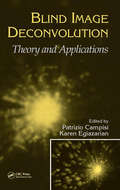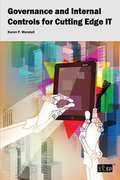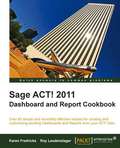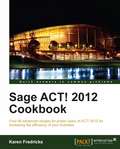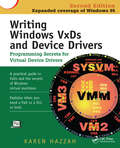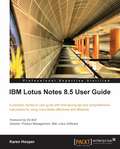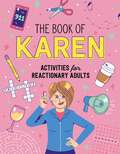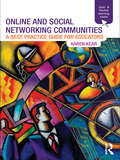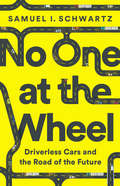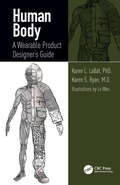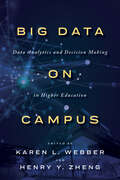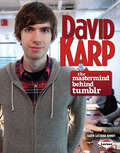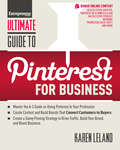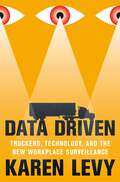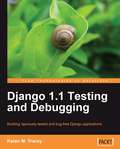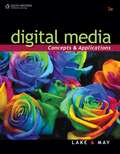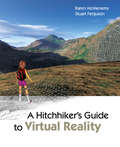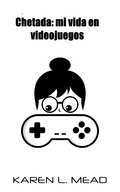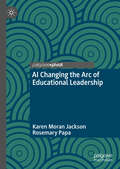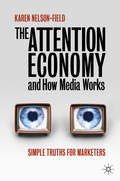- Table View
- List View
Blind Image Deconvolution: Theory and Applications
by Patrizio Campisi Karen EgiazarianBlind image deconvolution is constantly receiving increasing attention from the academic as well the industrial world due to both its theoretical and practical implications. The field of blind image deconvolution has several applications in different areas such as image restoration, microscopy, medical imaging, biological imaging, remote sensing, astronomy, nondestructive testing, geophysical prospecting, and many others. Blind Image Deconvolution: Theory and Applications surveys the current state of research and practice as presented by the most recognized experts in the field, thus filling a gap in the available literature on blind image deconvolution.Explore the gamut of blind image deconvolution approaches and algorithms that currently exist and follow the current research trends into the future. This comprehensive treatise discusses Bayesian techniques, single- and multi-channel methods, adaptive and multi-frame techniques, and a host of applications to multimedia processing, astronomy, remote sensing imagery, and medical and biological imaging at the whole-body, small-part, and cellular levels. Everything you need to step into this dynamic field is at your fingertips in this unique, self-contained masterwork.For image enhancement and restoration without a priori information, turn to Blind Image Deconvolution: Theory and Applications for the knowledge and techniques you need to tackle real-world problems.
Governance and Internal Controls for Cutting Edge IT
by Karen F. WorstellTo remain competitive we rely on being early adopters of new technologies - but there are inherent risks. As we implement these technologies, how do we manage the risks without hindering the progress of the business? In Governance and Internal Controls for Cutting Edge IT, Karen Worstell explains strategies and techniques to guide IT managers as they implement cutting edge solutions for their business needs. Based on practical experience and real-life models, she covers key principles and processes for the introduction of new technologies and examines how to establish an appropriate standard of security and control, particularly in the context of the COBIT 5® framework and affiliated standards. This book will enable you to apply security and control methods that are suitable for your business, ensure that you make the most of the potential benefits, and are aware of the potential risks of your IT provision. It will show you how the application of appropriate standards can improve stakeholder relationships and enhance your service management and delivery, enabling you to maximize the opportunities that are presented by compliance legislation and regulations. You will learn how to manage your data storage, recovery and migration - particularly in the context of the Cloud, ensure business continuity in the face of an incident, and implement strategies to cover the risk of business interruption.
Sage ACT! 2011 Dashboard and Report Cookbook
by Karen Fredricks Roy LaudenslagerThis is a cookbook of easy-to-follow recipes about ACT! 2011 dashboard and report practices. If you are an ACT! end user who wants to learn about the existing reports and dashboards available in ACT! 2009, 2010, and 2011, then this book is for you. If you are an ACT! administrator who wants to make changes to ACT!'s dashboard and reporting features or a sales manager who needs to measure the effectiveness of his sales force, you will also find this book helpful. New CRM users will learn how to measure the success of their database. Prior knowledge of ACT! is not essential; however, you'll find it helpful to have good working knowledge of how to add data to ACT!, or to work with an ACT! database that has already been populated with data.
Sage ACT! 2012 Cookbook
by Karen FredricksThis is an advanced cookbook of easy-to-follow recipes about ACT! 2012 designed to transform you into an ACT! Power User. If you are an ACT! end user who wants to learn about the advanced functionality of ACT! 2012, then this book is for you. It will also be useful if you are a 2009,2010 or 2011 user, as many advanced features originate from these ACT! versions. If you are an ACT! administrator who needs to administer an ACT! database or understand Outlook integration, you will also find this book helpful. No prior ACT! knowledge is necessarily required; however, you'll find it helpful to have good working knowledge of how to add data into ACT!, or to work with an ACT! database that has already been populated with data.
Writing Windows VxDs and Device Drivers
by Karen HazzahSoftware developer and author Karen Hazzah expands her original treatise on device drivers in the second edition of Writing Windows VxDs and Device Drivers. The book and companion disk include the author's library of wrapper functions that allow the progr
IBM Lotus Notes 8.5 User Guide: LITE
by Karen HoopeA compact Lotus Notes User Guide, this book covers best practices, hints, tips, and tricks of Lotus Notes 8.5 Client Interface and Mail features. It draws on real-world examples and you will find this book to be an invaluable reference for Lotus Notes. The material has been carefully selected from Packt's fuller IBM Lotus Notes 8.5 User Guide. If you are a business user who wants to get the most out of Lotus Notes, then this book is for you. From beginners to seasoned professionals, this book aims to cover the Client Interface and Mail features, best practices, tips, tricks, and tools that enable you to work smarter--almost effortlessly--in Lotus Notes 8.5.
IBM Lotus Notes 8.5 User Guide
by Karen HooperA compact Lotus Notes User Guide, this book covers best practices, hints, tips, and tricks of Lotus Notes 8.5. It draws on real-world examples and you will find this book to be an invaluable reference for Lotus Notes. There are significant changes from the earlier versions of Lotus Notes to the current version of 8.5 and this book covers the new features in detail so that you will be able to take advantage of them. However, this book also covers key features from earlier versions, which have stood the test of time. If you are a business user who wants to get the most out of Lotus Notes, then this book is for you. From beginners to seasoned professionals, this book aims to cover the features, best practices, tips, tricks, and tools that enable you to work smarter--almost effortlessly--in Lotus Notes 8.5.
The Book of Karen: Activities for Reactionary Adults
by Karen K. KlarenMazes Activities Games And more . . . ! Karen and Kevin demand a lot these days. From speaking to a manager to seeing birth certificates to requiring permits to sell lemonade, there's no 911 call they won't make, no social norm nor grace today's put-upon white person won't upend, in an effort to exercise and maintain their privilege. The Book of Karen: An Activity Book for Reactionary Adults demands only one thing: you laugh at them. Filled with the kinds of stickers, brain teasers, word searches, crossword puzzles, riddles, connect-the-dots, crafts, fill-in-the-blanks, and prompts found in any traditional adult activity book, The Book of Karen subverts and parodies the genre by highlighting the horrible behaviors of the entitled women and men whose videoed and memed behaviors would be comical were they not so condemnable. As much an activity book as as it is as call to action, The Book of Karen contains a comprehensive and useful list of anti-Karen nonprofits, especially those focusing on social justice, voting rights, pay equity, LGBTQIA rights, immigration, hunger and food instability, disability services, and victim's rights to raise awareness and for readers to support, learn more about, and work with to fight the status quo. A portion of the proceeds from The Book of Karen will directly go to benefit The Equal Justice Initiative, a non-profit committee working to end mass incarceration and excessive punishment, challenging racial and economic injustice, and protecting the basic human rights for the most vulnerable Americans.
Online and Social Networking Communities: A Best Practice Guide for Educators (Open and Flexible Learning Series)
by Karen KearOnline and Social Networking Communities is a professional guide written for educational practitioners and trainers who wish to use online communication tools effectively in their teaching. Focusing on the student experience of learning in online communities, it addresses ‘web 2.0’ and other ‘social software’ tools and considers the role these technologies play in supporting student learning and building learning communities. The guide offers: real-world case studies and quality research must-have lists of useful resources guidance on building and supporting online learning communities discussion of how collaborative learning can be assessed coverage of wikis, forums, blogging, instant messaging, Second Life, Twitter, desktop videoconferencing and social networking sites such as Facebook. Online and Social Networking Communities helps educators and trainers develop a critical approach by exploring online learning from both the student’s and educator’s perspective. This practical guide provides the tools to help develop confident and thoughtful online educators, able to create successful and enjoyable learning experiences for their students.
No One at the Wheel: Driverless Cars and the Road of the Future
by Karen Kelly Samuel I. SchwartzThe country's leading transport expert describes how the driverless vehicle revolution will transform highways, cities, workplaces and laws not just here, but across the globe. Our time at the wheel is done. Driving will become illegal, as human drivers will be demonstrably more dangerous than cars that pilot themselves. Is this an impossible future, or a revolution just around the corner?Sam Schwartz, America's most celebrated transportation guru, describes in this book the revolution in self-driving cars. The ramifications will be dramatic, and the transition will be far from seamless. It will overturn the job market for the one in seven Americans who work in the trucking industry. It will cause us to grapple with new ethical dilemmas-if a car will hit a person or a building, endangering the lives of its passengers, who will decide what it does? It will further erode our privacy, since the vehicle can relay our location at any moment. And, like every other computer-controlled device, it can be vulnerable to hacking.Right now, every major car maker here and abroad is working on bringing autonomous vehicles to consumers. The fleets are getting ready to roll and nothing will ever be the same, and this book shows us what the future has in store.
Human Body: A Wearable Product Designer's Guide
by Karen L. LaBat Karen S. RyanHuman Body: A Wearable Product Designer's Guide, unlike other anatomy books, is divided into sections pertinent to wearable product designers. Two introductory chapters include many definitions, an introduction to anatomical terminology, and brief discussions of the body's systems, setting the stage for the remaining chapters. The book is extensively referenced and has a large glossary with both anatomical and design terms making it maximally useful for interdisciplinary collaborative work. The book includes 200 original illustrations and many product examples to demonstrate relationships between wearable product components and anatomy. Exercises introduce useful anatomical, physiological, and biomechanical concepts and include design challenges. Features Includes body region chapters on head and neck, upper torso and arms, lower torso and legs, the mid-torso, hands, feet, and a chapter on the body as a whole Contains short sections on growth and development, pregnancy, and aging as well as sections on posture, gait, and designing total body garments Describes important regional muscles and their actions as well as joint range of motion (ROM) definitions and data with applications to designing motion into wearable products Presents appendices correlating to each body region’s anatomy with instructions for landmarking and measuring the body, a valuable resource for a lifetime of designing
Big Data on Campus: Data Analytics and Decision Making in Higher Education
by Karen L. Webber and Henry Y. ZhengHow data-informed decision making can make colleges and universities more effective institutions.The continuing importance of data analytics is not lost on higher education leaders, who face a multitude of challenges, including increasing operating costs, dwindling state support, limits to tuition increases, and increased competition from the for-profit sector. To navigate these challenges, savvy leaders must leverage data to make sound decisions. In Big Data on Campus, leading data analytics experts and higher ed leaders show the role that analytics can play in the better administration of colleges and universities. Aimed at senior administrative leaders, practitioners of institutional research, technology professionals, and graduate students in higher education, the book opens with a conceptual discussion of the roles that data analytics can play in higher education administration. Subsequent chapters address recent developments in technology, the rapid accumulation of data assets, organizational maturity in building analytical capabilities, and methodological advancements in developing predictive and prescriptive analytics. Each chapter includes a literature review of the research and application of analytics developments in their respective functional areas, a discussion of industry trends, examples of the application of data analytics in their decision process, and other related issues that readers may wish to consider in their own organizational environment to find opportunities for building robust data analytics capabilities.Using a series of focused discussions and case studies, Big Data on Campus helps readers understand how analytics can support major organizational functions in higher education, including admission decisions, retention and enrollment management, student life and engagement, academic and career advising, student learning and assessment, and academic program planning. The final section of the book addresses major issues and human factors involved in using analytics to support decision making; the ethical, cultural, and managerial implications of its use; the role of university leaders in promoting analytics in decision making; and the need for a strong campus community to embrace the analytics revolution. Contributors: Rana Glasgal, J. Michael Gower, Tom Gutman, Brian P. Hinote, Braden J. Hosch, Aditya Johri, Christine M. Keller, Carrie Klein, Jaime Lester, Carrie Hancock Marcinkevage, Gail B. Marsh, Susan M. Menditto, Jillian N. Morn, Valentina Nestor, Cathy O'Bryan, Huzefa Rangwala, Timothy Renick, Charles Tegen, Rachit Thariani, Chris Tompkins, Lindsay K. Wayt, Karen L. Webber, Henry Y. Zheng, Ying Zhou
David Karp: The Mastermind behind Tumblr (Gateway Biographies Ser.)
by Karen Latchana KenneyWhat's more popular than Tumblr? This microblogging site has taken the Web by storm since its founding in 2007. Not much can top it when it comes to capturing its fans' imaginations, except for perhaps its creator, David Karp. Karp developed Tumblr after he tried to start a blog and found the process daunting. With most platforms, a blogger faces a huge, empty text box that begs to be filled with words. It was intimidating for a guy who'd never blogged before. Karp had the idea for tumblelogging—creating short blog posts—and built Tumblr as a platform. It lets users easily post both text and images, making Tumblr highly visual and expressive. Creating a different way to blog came naturally to Karp, who never does things by the book. At fifteen, he dropped out of school. At seventeen, he moved to Tokyo, holing up with a computer and fine-tuning his tech skills. He returned to the states to build a business—but to do that, he stretched the truth. He used a deep voice on the phone with potential clients so they wouldn't guess how young he was. He didn't tell anyone how little experience he had. Yet people could see he had a good thing going with Tumblr. The company quickly found support and grew into what it is today: a groundbreaking site for connection and creation. And as the mastermind behind it, Karp is sure to remain a figure to watch.
Ultimate Guide to Pinterest for Business
by Karen LelandWith 4,000 percent growth in just six months, 17 million users, and a record for more referral traffic than YouTube, Google+, and LinkedIn combined, Pinterest delivers an unbelievable opportunity for marketers . . . if they know how to effectively use it. Karen Leland acquaints business owners with the newest social media kid on the block. She covers: the ins and outs of signing up and getting started; building boards that get noticed, drive traffic, and convert fans into customers; creating a Pinterest community through power connections, contests, social media outreach, and smart pinning strategies; strategies for becoming a power Pinterest user and creating an enthusiastic following; best practices for pins that promote, including image optimization, consistent branding, social media integration, and high-value content; and Pinterest etiquette. Business owners learn to expand their business and brand's success - one pin at a time.
Data Driven: Truckers, Technology, and the New Workplace Surveillance
by Karen LevyA behind-the-scenes look at how digital surveillance is affecting the trucking way of lifeLong-haul truckers are the backbone of the American economy, transporting goods under grueling conditions and immense economic pressure. Truckers have long valued the day-to-day independence of their work, sharing a strong occupational identity rooted in a tradition of autonomy. Yet these workers increasingly find themselves under many watchful eyes. Data Driven examines how digital surveillance is upending life and work on the open road, and raises crucial questions about the role of data collection in broader systems of social control.Karen Levy takes readers inside a world few ever see, painting a bracing portrait of one of the last great American frontiers. Federal regulations now require truckers to buy and install digital monitors that capture data about their locations and behaviors. Intended to address the pervasive problem of trucker fatigue by regulating the number of hours driven each day, these devices support additional surveillance by trucking firms and other companies. Traveling from industry trade shows to law offices and truck-stop bars, Levy reveals how these invasive technologies are reconfiguring industry relationships and providing new tools for managerial and legal control—and how truckers are challenging and resisting them.Data Driven contributes to an emerging conversation about how technology affects our work, institutions, and personal lives, and helps to guide our thinking about how to protect public interests and safeguard human dignity in the digital age.
Django 1.1 Testing and Debugging
by Karen M. TraceyThis book teaches by example. It walks in detail through development of a sample application, illustrating each step via complete working code and either screenshots or console snippets. The cumbersome and time consuming task of debugging will be a cake walk with this book. If you are a Django application developer who wants to create robust applications quickly that work well and are easy to maintain in the long term, this book is for you. This book is the right pick if you want to be smartly tutored to make best use of Django's rich testing and debugging support and make testing an effortless task. Basic knowledge of Python, Django, and the overall structure of a database-driven web application is assumed. However, the code samples are fully explained so that even beginners who are new to the area can learn a great deal from this book.
Digital Media: Concepts and Applications (3rd Edition)
by Susan E. L. Lake Karen MayDIGITAL MEDIA, CONCEPTS AND APPLICATIONS, 3E prepares students for the workplace by teaching them to use business-standard software applications to complete projects and solve problems. The non-software-specific approach gives students a strong foundation in the concepts and practices of digital multimedia and allows the text to focus on the more creative end of business technology.
Personalising Learning in Teacher Education
by Mellita Jones Karen McLeanThis volume sheds light on debates about personalised learning in teacher education by exploring the popular emergence of personalising learning in education and hence its significance in teacher education in the 21st century. It examines personalising learning theory and explores the tenets of this theory and its recent trends in international settings. The theory is explored in relation to both general and higher education pedagogy, and in a range of examples within a teacher education context. The examples from practice provide insights into maximising the potential for personalising learning theory to enhance teaching, learning and assessment in teacher education. The book includes case studies involving pre-service teachers working in communities of practice with one another, with schools and with the wider community. Examples of technology for personalising learning are also described. All the case studies demonstrate how the learner is made central to the teaching and assessment approaches adopted and contributes to a lifelong learning continuum. Providing insights into a new pedagogy for teacher education that leads to an enriched student experience, the book presents a model for personalising learning in teacher education that offers support for 21st century teacher educators.
A Hitchhiker's Guide to Virtual Reality
by Karen McMenemy Robin Stuart FergusonA Hitchhiker's Guide to Virtual Reality brings together under one cover all the aspects of graphics, video, audio, and haptics that have to work together to make virtual reality a reality. Like any good guide, it reveals the practical things you need to know, from the viewpoint of authors who have been there. This two-part guide covers the science, technology, and mathematics of virtual reality and then details its practical implementation. The first part looks at how the interface between human senses and technology works to create virtual reality, with a focus on vision, the most important sense in virtual reality. The second part of the book is tightly integrated with an accompanying CD, which contains the programs for more than 30 virtual reality projects, ranging in scope from a tool that simulates virtual sculpting to a suite of software for the control of a four-projector immersive virtual environment.
Content Strategy for Mobile
by Karen McgraneThis book discusses how to manage, publish and maintain your content across all emerging mobiles; by creating a holistic content strategy that can be used on a variety of devices.
Chetada: mi vida en videojuegos
by Karen MeadEn Chetada: mi vida en videojuegos, la escritora Karen L. Mead echa un vistazo a su larga historia videojueguil e intenta descubrir qué está pasando. ¿Cómo los recuerdos del tiempo gastado en mundos imaginarios se relacionan con nuestros recuerdos de sitios reales? ¿Es posible que los recuerdos de los juegos sean de alguna forma más genuinos que los recuerdos de sitios reales, y si lo son, por qué? Mead mira a los increíblemente populares videojuegos que definieron una era, como Super Mario Bros., Final Fantasy VII y Starcraft, entre otros, para ver cómo estos juegos se convirtieron tanto en una parte de su vida como un escape de ella.
AI Changing the Arc of Educational Leadership
by Rosemary Papa Karen Moran JacksonAs artificial intelligence becomes an all-encompassing issue in education and beyond, this book seeks to answer how it will change the arc of educational leadership in K-12 schooling. Educators and leaders serve as the champions and gatekeepers of technology use in schools. They need to consider how AI can change education for the better while keeping in mind cultural, social, and emotional concerns that cannot be isolated from educational settings. Jackson and Papa examine existing literature and include insightful interviews with professionals in AI and education to understand how educators currently perceive and use AI. They also illustrate the similarities and differences in how educators and A.I.ED developers envision AI's present and future.
The Attention Economy and How Media Works: Simple Truths for Marketers
by Karen Nelson-FieldThis book offers a considered voice on the advertising chaos that colours our rapidly changing media environment in a world of fake news, fast facts and seriously depleted attention stamina. Rather than simply herald disruption, Karen Nelson-Field starts an intelligent conversation on what it will take for businesses to win in an attention economy, the advertising myths we need to leave behind and the scientific evidence we can use to navigate a complex advertising and media ecosystem. This book makes sense of viewability standards, coverage and clutter; it talks about the real quality behind a qCPM and takes a deep dive into the relationship between attention and sales. It explains the stark reality of human attention processing in advertising. Readers will learn how to maximise a viewer’s divided attention by leveraging specific media attributes and using attention-grabbing creative triggers. Nelson-Field asks you to pay attention to a disrupted advertising future without panic, but rather with a keen eye on the things that brand owners can learn to control.
The Attention Economy: A Category Blueprint
by Karen Nelson-FieldIn this compelling sequel, The Attention Economy: A Category Blueprint, takes an in-depth look into the dynamic world of marketing and advertising, unveiling the pivotal role that human attention measurement plays in the present and future landscape. Designed for industry professionals, this book serves as a blueprint, offering profound insights and actionable advice.The book begins by reflecting on the whirlwind of transformations that have shaped the marketing landscape over the past three decades. It then examines the perfect storm of events that has propelled attention economics to the forefront of the industry's agenda. Throughout its chapters, the book catalogs cutting-edge research and tackles critical issues such as attention measurement, metrics, prediction, distraction, data quality and the ethical use of attention data ultimately piecing together the intricate puzzle and offering clarity for industry professionals.Industry leaders and early adopters contribute their insights, offering valuable perspectives on their own experiences and practical applications of attention data.The book’s engaging style blends quick tips, simple explanations of complex concepts and humorous anecdotes to make the content accessible and enjoyable. By blending storytelling and practical advice, the book succeeds in demystifying the intricate world of attention economics.This book is a must-read for marketing professionals seeking to understand the evolving landscape of advertising. It offers a blueprint for change and foresight into the future of the attention economy. In doing so, it becomes an invaluable resource for anyone navigating the challenges and opportunities of today's marketing world.
Universal Design for Learning in the Early Childhood Classroom: Teaching Children of all Languages, Cultures, and Abilities, Birth – 8 Years
by Karen Nemeth Pamela BrillanteUniversal Design for Learning in the Early Childhood Classroom focuses on proactively designing PreK through Grade 3 classroom environments, instruction, and assessments that are flexible enough to ensure that teachers can accommodate the needs of all the students in their classrooms. Typically developing students, gifted students, students who are impacted by poverty, children who speak multiple languages or have a home language that is different than the classroom language, and students with identified or potential developmental or learning disabilities are all covered within this highly practical, easy-to-use guide to UDL in the early years.
